CeO2/SWCNT nanocomposite coating: A novel approach for corrosion application
IF 3.4
4区 工程技术
Q2 POLYMER SCIENCE
引用次数: 0
Abstract
The coatings were prepared by blending different concentrations of SWCNTs and CeOCeO2/SWCNT 纳米复合涂层:腐蚀应用的新方法
通过水热法将不同浓度的 SWCNTs 和 CeO2 颗粒与环氧树脂混合制备涂层,然后通过刮刀技术将其涂在基底上。将混合物转移到带聚四氟乙烯内衬法兰的 1 升容量高压釜中,在 100°C 下进行 3 小时的水热处理。随后,将涂层材料放入烘箱,在 50°C 的真空条件下干燥 12 小时。样品的结构分析通过 X 射线衍射(XRD)进行。XRD 分析验证了 CeO2/SWCNT 复合涂层,傅立叶变换红外光谱(FTIR)用于评估官能团的存在。热重分析 (TGA) 研究了用 SWCNT 和 CeO2 粒子改性的复合涂层的热力学性质和热稳定性。通过电化学阻抗光谱(EIS)、奈奎斯特曲线和塔菲尔斜率表征,研究了 CeO2/SWCNT 复合材料对环氧涂层防腐能力的影响。在 25°C 的 3.5 wt% 氯化钠 (NaCl) 溶液中对 CeO2/SWCNT 复合涂层进行了腐蚀测试,以提高其耐腐蚀性。结果发现,0.4 wt% 的 CeO2 浓度是实现有效耐腐蚀性的最佳浓度。与 CNT0、CNT0.2 和 CNT0.6 组的样品相比,CNT0.6-C0.4 复合涂层的 Ecorr 值(-426 V)明显更高,Icorr 值(2.96 × 10-6 A cm-2)明显更低。本文为腐蚀抑制涂层的工程应用提出了一种可行的 CeO2/SWCNT 复合涂层解决方案。
本文章由计算机程序翻译,如有差异,请以英文原文为准。
求助全文
约1分钟内获得全文
求助全文
来源期刊

Polymers for Advanced Technologies
工程技术-高分子科学
CiteScore
6.20
自引率
5.90%
发文量
337
审稿时长
2.1 months
期刊介绍:
Polymers for Advanced Technologies is published in response to recent significant changes in the patterns of materials research and development. Worldwide attention has been focused on the critical importance of materials in the creation of new devices and systems. It is now recognized that materials are often the limiting factor in bringing a new technical concept to fruition and that polymers are often the materials of choice in these demanding applications. A significant portion of the polymer research ongoing in the world is directly or indirectly related to the solution of complex, interdisciplinary problems whose successful resolution is necessary for achievement of broad system objectives.
Polymers for Advanced Technologies is focused to the interest of scientists and engineers from academia and industry who are participating in these new areas of polymer research and development. It is the intent of this journal to impact the polymer related advanced technologies to meet the challenge of the twenty-first century.
Polymers for Advanced Technologies aims at encouraging innovation, invention, imagination and creativity by providing a broad interdisciplinary platform for the presentation of new research and development concepts, theories and results which reflect the changing image and pace of modern polymer science and technology.
Polymers for Advanced Technologies aims at becoming the central organ of the new multi-disciplinary polymer oriented materials science of the highest scientific standards. It will publish original research papers on finished studies; communications limited to five typewritten pages plus three illustrations, containing experimental details; review articles of up to 40 pages; letters to the editor and book reviews. Review articles will normally be published by invitation. The Editor-in-Chief welcomes suggestions for reviews.
 求助内容:
求助内容: 应助结果提醒方式:
应助结果提醒方式:


